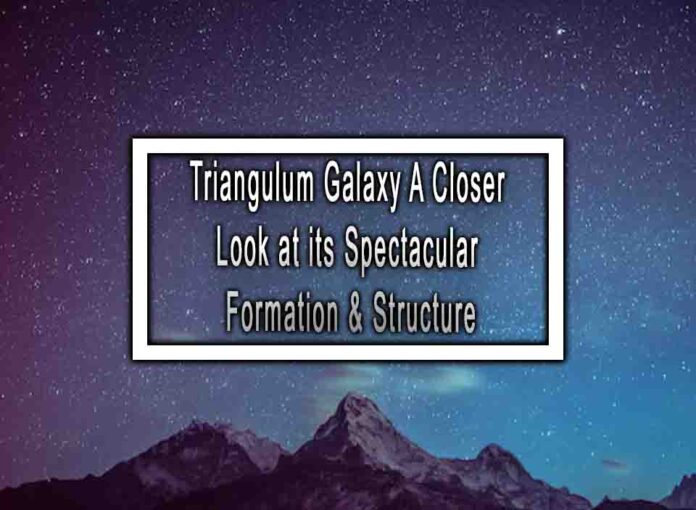The Triangulum Galaxy, also known as Messier 33 (M33) or NGC 598, is a spectacular spiral galaxy located in the constellation Triangulum. It is one of the closest spiral galaxies to our Milky Way and provides an excellent opportunity to study the formation and structure of such galaxies. Let’s take a closer look at the Triangulum Galaxy’s formation and structure:
1. Spiral Structure:
The Triangulum Galaxy is a classic spiral galaxy, characterized by its prominent spiral arms. It is classified as Sc type, indicating that it has loosely wound spiral arms and an open appearance.
2. Size and Proximity:
M33 is relatively small compared to the Milky Way and the Andromeda Galaxy (M31). It has a diameter of about 60,000 light-years and is located approximately 3 million light-years away from Earth, making it one of the closest spiral galaxies to us.
3. Stellar Populations:
The Triangulum Galaxy hosts a wide range of stellar populations, from young, hot, and massive stars in its spiral arms to older, cooler stars in its central bulge. Observing these stars provides valuable information about the galaxy’s age and evolution.
4. Star Formation:
M33 is actively forming new stars in its spiral arms. Dense regions of gas and dust, often visible as bright HII regions, are where massive stars are born. The study of star formation in M33 helps astronomers understand the process in different environments.
5. Halo and Globular Clusters:
Like other galaxies, the Triangulum Galaxy has a halo of stars that extends beyond its visible disk. It also contains a system of globular clusters, which are dense collections of ancient stars. These clusters are valuable for studying the galaxy’s history.
6. Dark Matter Halo:
The Triangulum Galaxy, like most galaxies, is believed to be embedded in a massive halo of dark matter, which exerts gravitational influence on its visible matter. Understanding the distribution of dark matter in M33 is a subject of ongoing research.
7. Satellite Galaxies:
M33 has several satellite galaxies, including the dwarf galaxies Triangulum II and Triangulum III. Studying these satellites provides insights into the gravitational interactions and evolution of the Triangulum system.
8. Formation Mechanisms:
The formation of the Triangulum Galaxy, like other spiral galaxies, is thought to involve the collapse of a rotating gas and dust cloud. Understanding the specific mechanisms behind its spiral structure and disk formation is an ongoing area of research.
9. Interaction with Andromeda:
M33 is gravitationally bound to the larger Andromeda Galaxy (M31) and is part of the Local Group of galaxies along with the Milky Way. The future interaction between M31, the Milky Way, and M33 is a topic of interest, as it provides insights into the dynamics of galaxy groups.
10. Astronomical Observations:
The Triangulum Galaxy is a popular target for amateur astronomers and professional observatories alike. Its relatively close proximity and large angular size make it a fascinating subject for deep-sky observations and astrophotography.
The Triangulum Galaxy, with its intricate structure and active star formation, serves as a valuable laboratory for understanding the dynamics, formation, and evolution of spiral galaxies. It offers a window into the broader processes that shape galaxies across the universe, making it an essential part of the study of the cosmos.










